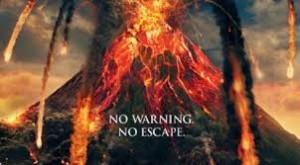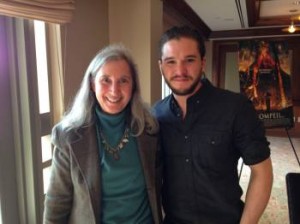Pompeii
Posted on February 20, 2014 at 6:00 pm
 In 79 AD Mount Vesuvius erupted, wiping out the city of Pompeii. Director Paul W.S. Anderson, who gave us movie versions of “Resident Evil” and “Mortal Kombat,” presents the story as a video game. If what you are looking for is special effects and well-staged action, or even buff bodies, you’re all set. But those who are looking for history, meaningful drama, character development, or good dialog — well, they weren’t paying attention a moment ago when I mentioned the director of game console-to-movie theater movies and Paul W.S. Anderson. It is basically “The Legend of Hercules” with a volcano.
In 79 AD Mount Vesuvius erupted, wiping out the city of Pompeii. Director Paul W.S. Anderson, who gave us movie versions of “Resident Evil” and “Mortal Kombat,” presents the story as a video game. If what you are looking for is special effects and well-staged action, or even buff bodies, you’re all set. But those who are looking for history, meaningful drama, character development, or good dialog — well, they weren’t paying attention a moment ago when I mentioned the director of game console-to-movie theater movies and Paul W.S. Anderson. It is basically “The Legend of Hercules” with a volcano.
“Game of Thrones'” Kit Harington plays Milo, who as a child saw his entire community brutally slaughtered by the vicious and corrupt Roman soldier Corvus (an imperious Kiefer Sutherland). Milo escaped by hiding in a pile of dead bodies. He is later captured and sold into slavery, where his outstanding fighting skills bring him to the attention of a purveyor of gladiator battle-to-the-death entertainment. He travels to the big city of Pompeii to compete in the arena there. Along the way, he sees a beautiful young woman named Cassia (Emily Browning) and he impresses her by putting her injured horse out of its misery. Cassia is returning to her parents (Jared Harris and Carrie-Ann Moss) after a visit to Rome, where she attracted the attention of Corvus, now a high-ranking Senator. But Milo has attracted her attention. In an example of dialog that could have come out of a middle school slam book, a character says, “I never saw you look at any man the way you looked at that slave.”
Milo is set to fight the enormous and powerful Atticus (“Thor’s” Adewale Akinnuoye-Agbaje), who can earn not just his life but his freedom with one more win in the arena. They end up forming an alliance like that of Kirk Douglas and Woody Strode in the classic “Spartacus.” Meanwhile Corvus is attempting to extort Cassia’s hand in marriage from her father, who needs the support of Rome for his building project.
And all of this is about to be trumped by a nearby mountain and some seismic movement of the earth. There are huge sinkholes and then there is an ocean of burning lava and chokingly thick ash. Every element of the lives of the Pompeiians is turned upside down as all societal restrictions are removed and all anyone wants to do is stay alive. Well, you’d think that, but unfortunately the storylines that have already more than overstayed their welcome drag on, interfering with what we really want to see — the special effects — and jettisoning any possible remaining legitimacy of the plot.
Harington is very good as Milo and he and the excellent Akinnuoye-Agbaje make the fight scenes exciting and compelling. Sutherland has a nice sneer (I could not help remembering his bully in “Stand By Me.”) The special effects, especially in 3D, are impressive. But the movie is dragged down by its cheesy storyline.
This is not the first movie version of the story of Pompeii and it will not be the last. Pliny the Younger’s eyewitness description of what happened when the volcano erupted excerpted in the opening moments of the film, is still more vivid and powerful than any version yet put on screen.
You might hear the Shrieks of Women, the Cries of Children, the Noise of Men: Some called aloud for their Parents, some for their Husbands, and knew them only by their Voices; some bewailed their own Share in the Calamity; and others that of their Neighbours; some wished for Death from the Fear of Dying; many lifted up their Hands to Heaven; a Multitude disbelieved all the Gods, and looked upon the Time to be the last eternal Night, that has been prophesied. Some improved the real Dangers by feigned and imaginary Fears; others gave it out, that this House at Misenum was fallen, that was burnt; both falsely, but they met with Believers. A Glimpse of Light appeared, that did not show us the Return of Day, but the Approach of the Fire that threatened us: The Fire indeed, stood at a Distance; then the Darkness revived, and after that, a plentiful Shower of Ashes and Cinders: We rose up now and then and shook them off, otherwise we should have been covered and oppressed with the Weight of them. I could boast, that neither a Sigh, nor a complaining Expression dropped from me in the midst of these Alarms; but I was supported by this Consolation, not very Reasonable indeed, but natural enough, to think that all the World perished with me.
Parents should know that this film has extensive sword and sandal-era violence including the slaughter of a village, a child seeing his parents get killed, a horse put down, and many gladiator fighting scenes with many characters injured and killed. Also, natural disaster violence destroys an entire city with some disturbing images and there is a brief sexual situation (slaves as prostitutes) and reference to a brothel.
Family discussion: Why didn’t Milo want to say his name? What kind of culture finds gladiator fighting entertaining?
If you like this, try: read up on the real history of Pompeii and watch classics like “Gladiator,” “Ben Hur” and “Spartacus”



